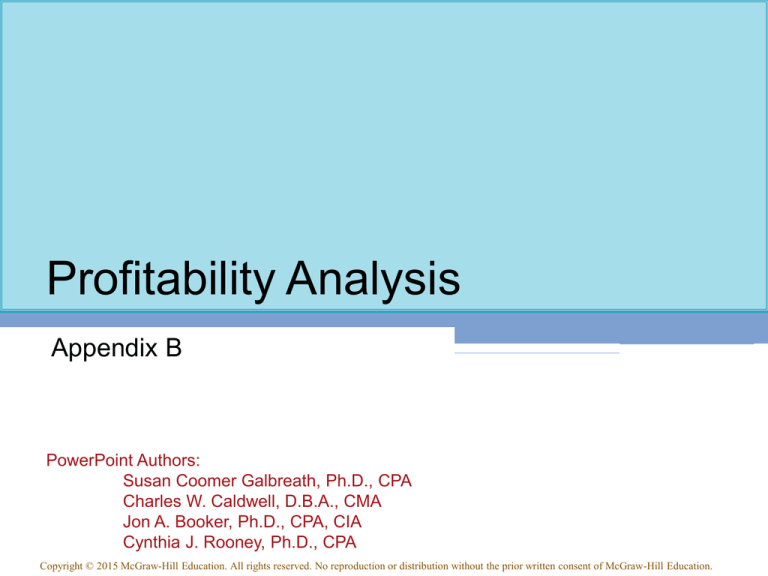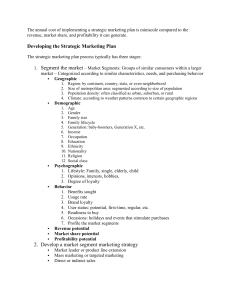
Profitability Analysis
Appendix B
PowerPoint Authors:
Susan Coomer Galbreath, Ph.D., CPA
Charles W. Caldwell, D.B.A., CMA
Jon A. Booker, Ph.D., CPA, CIA
Cynthia J. Rooney, Ph.D., CPA
Copyright © 2015 McGraw-Hill Education. All rights reserved. No reproduction or distribution without the prior written consent of McGraw-Hill Education.
B-2
Absolute Profitability
Absolute profitability measures the impact on the
organization’s overall profits of adding or dropping
a particular segment such as a product or
customer – without making any other changes.
B-3
Computing Absolute Profitability
For an Existing Segment
Compare the revenues that would be lost from
dropping that segment to the costs that
would be avoided.
For a New Segment
Compare the additional revenues from adding
that segment to the costs that would be incurred.
B-4
Relative Profitability
Relative profitability is concerned with ranking
products, customers, and other business segments
to determine which should be emphasized in an
environment of scarce resources.
B-5
Relative Profitability
Managers are interested in ranking segments if a
constraint forces them to make trade-offs among
segments.
In the absence of a constraint, all segments that are
absolutely profitable should be pursued.
B-6
Relative Profitability
Incremental profit from the segment is
the absolute profitability of the segment.
Incremental profit from the segment
Profitability
=
index
Amount of the constrained
resources required by the segment
B-7
Project Profitability Index
From Chapter 13
Project
profitability
index
=
Net present value of the project
Amount of investment
required by the project
The project profitability index is used
when a company has more long-term projects
with positive net present values than it can fund.
B-8
Project Profitability Index
From Chapter 13
Project
profitability
index
=
Net present value of the project
Amount of investment
required by the project
The net present value of the project
goes in the numerator since it represents
the incremental profit from the segment.
B-9
Project Profitability Index
From Chapter 13
Project
profitability
index
=
Net present value of the project
Amount of investment
required by the project
The investment funds are the
constraint, so the amount of investment
required by a project goes in the denominator.
B-10
Quality Kitchen Design – An Example
Project A
Incremental
Profit
Constrained
Resource
Required
Profitability Index
(a)
(b)
(a) ÷ (b)
$
9,180
17 hours
$
540 per hour
Project B
7,200
9 hours
800 per hour
Project C
7,040
16 hours
440 per hour
Project D
5,680
8 hours
710 per hour
Project E
5,330
13 hours
410 per hour
Project F
4,280
4 hours
1,070 per hour
Project G
4,160
13 hours
320 per hour
Project H
3,720
12 hours
310 per hour
Project I
3,650
5 hours
730 per hour
Project J
2,940
3 hours
100 hours
980 per hour
B-11
Quality Kitchen Design – An Example
Project A
Incremental
Profit
Constrained
Resource
Required
Profitability Index
(a)
(b)
(a) ÷ (b)
9,180
17 hours
Project B
7,200
9 hours
800 per hour
Project C
7,040
16 hours
440 per hour
Project D
Project E
Project F
Project G
$
$
540 per hour
If management
8 hours
710 per hour
only 5,330
has 46 hours
13 hoursavailable,
410 per hour
4,280 projects
4 hoursshould
1,070 per hour
which
4,160be accepted?
13 hours
320 per hour
5,680
Project H
3,720
12 hours
310 per hour
Project I
3,650
5 hours
730 per hour
Project J
2,940
3 hours
100 hours
980 per hour
B-12
Ranking Based on Profitability Index
Project F
Incremental
Profit
Constrained
Resource
Required
Profitability
Index
(a)
(b)
(a) ÷ (b)
4,280
4 hours
Project J
2,940
Project B
$
Incremental
Profit
1,070
4 hours
3 hours
980
7 hours
2,940
7,200
9 hours
800
16 hours
7,200
Project I
3,650
5 hours
730
21 hours
3,650
Project D
5,680
8 hours
710
29 hours
5,680
Project A
Project C
9,180
7,040
17 hours
16 hours
540
440
46 hours
62 hours
9,180
32,930
410
75 hours
Project E
$
Cumulative
Hours
5,330
13 hours
Organize
projects
from
Project G
4,160
13 hours
highest
profitability
index to
Project
H
3,720
12 hours
100 hours
lowest profitability
index.
320
310
$
$
4,280
88 hours
100 hours
There
are only 48
hours available.
B-13
Ranking Based on Profitability Index
Project F
Incremental
Profit
Constrained
Resource
Required
Profitability
Index
(a)
(b)
(a) ÷ (b)
4,280
4 hours
Project J
2,940
Project B
4 hours
3 hours
980
7 hours
2,940
7,200
9 hours
800
16 hours
7,200
Project I
3,650
5 hours
730
21 hours
3,650
Project D
5,680
8 hours
710
29 hours
5,680
Project A
Project C
9,180
7,040
17 hours
16 hours
540
440
46 hours
62 hours
9,180
32,930
Project E
5,330
13 hours
410
75 hours
Project G
4,160
13 hours
320
88 hours
310
100 hours
Pursue
3,720 these
12 hours
projects. 100 hours
$
Incremental
Profit
1,070
Project H
$
Cumulative
Hours
$
$
4,280
The optimal profit
B-14
Volume Trade-Off Decisions
Volume trade-off decisions need to be made
when a company must produce less than the
market demands for some products due to the
existence of a constraint.
B-15
Volume Trade-Off Decisions
Volume trade-off decisions need to be made
when a company must produce less than the
market demands for some products due to the
existence of a constraint.
Profitability index
for a volume =
trade-off decision
Unit contribution margin
Amount of the constrained resource
required by one unit
B-16
Pricing New Products
The price of a new product should at least cover
the variable cost of producing it plus the
opportunity cost of displacing the production of
existing products to make it.
Selling price Variable cost
of new
≥ of the new +
product
product
Amount of the
Opportunity cost
constrained
per unit of the
×resource required
constrained
by a unit of the
resource
new product
B-17
End of Appendix B









